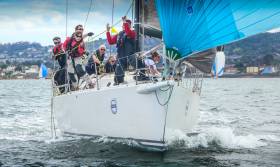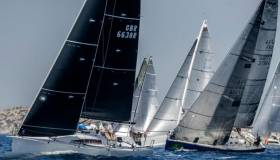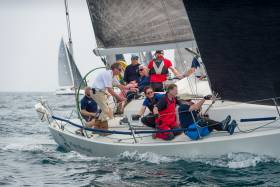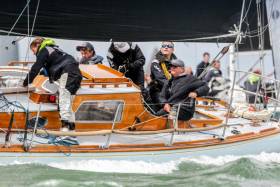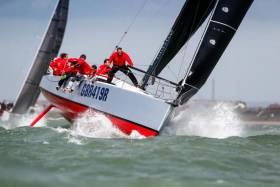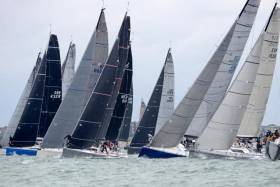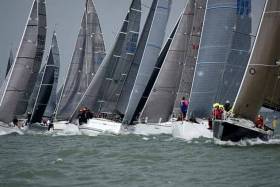Displaying items by tag: IRC
ISORA Night Race Line Honours IRC Overall & IRC Class 0 for Royal St. George's 'Aurelia'
What has been ideal night sailing conditions for this race in past seasons was certainly not ideal last Friday night, 18th August, for ISORA’s Night Race. Weather forecasts all agreed on what faced the fleet of 18–boats that came to the start line writes Peter Ryan, Chairman of ISORA.
Four other boats had earlier pulled out. All forecasts were promising westerly winds of 25–knots and gusting. This was to remain before moderating by early morning.
Due to the conditions the Sailing Committee decided not to use the traditional turning mark on the course, North Arklow, but instead use an inshore course, keeping the fleet away from the banks. The course was: Start at Dun Laoghaire – North Burford (S) – Killiney Outfall (P) – Breeches Buoy (P) – South Burford (S) – Finish between the pier heads in Dun Laoghaire – 36 miles.
The race started in the 25 knots of westerly wind, sending the fleet fast broad reaching towards North Burford. Some of the boats attempted to hoist spinnakers but no great advantage was gained due to handling difficulties as the westerly winds gusted up to 32 knots. Daragh Cafferkey’s “Another Adventure” was first to round followed by Chris Power-Smith’s “Aurelia”.
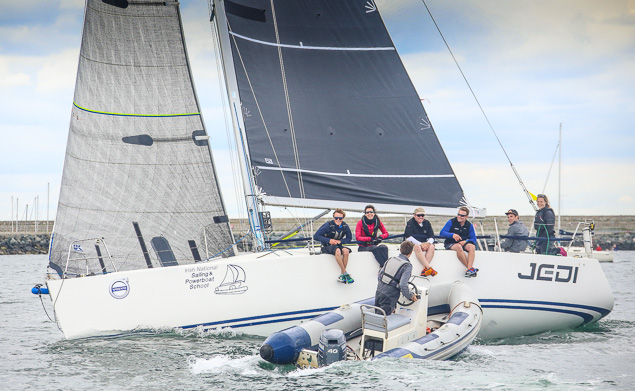 Just back from a top showing at the Rolex Fastnet Race, Kenny Rumball's Jedi from the Irish National Sailing School competed in ISORA's night race and won Class One Photo: Afloat.ie
Just back from a top showing at the Rolex Fastnet Race, Kenny Rumball's Jedi from the Irish National Sailing School competed in ISORA's night race and won Class One Photo: Afloat.ie
The next leg was a loose fetch / tight reach down to Killiney Bay. The fleet had split at this stage. “Aurelia” had passed “Another Adventure” to round that mark first. Close behind the leaders was Kenneth Rumball’s “Jedi” of the INSS and Roger Smith’s “Wakey Wakey” and Vincent Farrell’s “Tsunami”.
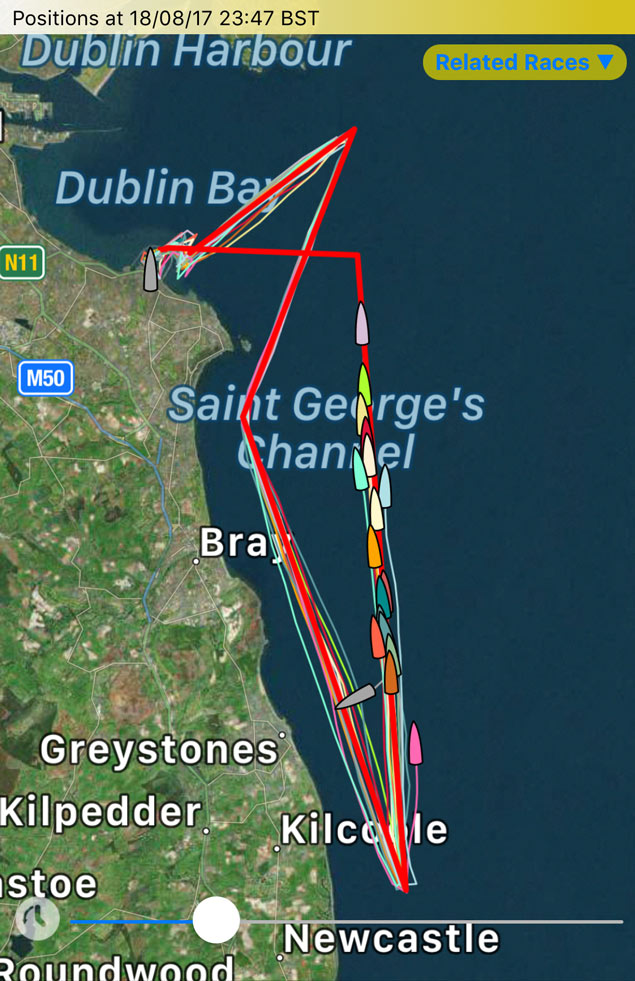 18–boats came to the start line for the ISORA night race along the Dublin and Wicklow coast
18–boats came to the start line for the ISORA night race along the Dublin and Wicklow coast
The next long leg south to Breeches was another broad reach but this time those boats who ventured to hoist spinnakers broke away from the fleet, despite the many broaches. Rounding Breeches Buoy, “Aurelia” still was maintaining its lead just ahead of “Another Adventure”.
The following leg was a fetch north to South Burford. “Aurelia” had by this time extended its lead from “Another Adventure” followed by “Jedi”, Colm Buckley’s “Indian”, “Tsunami” and Paul Egan’s “Platinum Blonde”.
The last leg to the finish was a beat. “Aurelia” continued to extend his lead and took Line Honours, IRC Overall and IRC Class 0. “Jedi” just pipped “Another Adventure” by 26 seconds to take 2nd IRC Overall and IRC Class 1. Derek Dillon’s “Big Deal” took IRC Class 2.
In ECHO, Jim Schofield’s “Thisbe” took Overall and Class 2. “Aurelia” took Class 0 while “Jedi” took Class 1. Full results can be found here
The next race takes place next Saturday, 26th August, a day race from Dun Laoghaire to Greystones. This is one feeder race to the Greystones Regatta to take place the following day. A fleet of 25 boats from a list of 33 entries are expected to make their way to the start line.
 J109 Mojito holds a narrow lead in the overall Avery Crest Offshore Championship going into the Dun Laoghaire–Greystones race this weekend. Photo: Afloat.ie
J109 Mojito holds a narrow lead in the overall Avery Crest Offshore Championship going into the Dun Laoghaire–Greystones race this weekend. Photo: Afloat.ie
The Overall Avery Crest Offshore Championship is hotting up with “Mojito” slightly ahead of the current Champion “Sgrech” and followed closely by “Jedi” and “Aurelia”. With a large fleet expected for the last offshore from Pwllheli to Dun Laoghaire on the 9th September, it is possible for any one of those boats to snatch the coveted “Wolf’s Head” trophy.
Irish Raiders 'Fools Gold' Win IRC Welsh Championships
With light winds forecast for the final day, the fleet left the event pontoons to the two racing areas in glorious sunshine, a relief to shed the wet weather gear! IRC 1 and 2 sailed two windward/leeward races off shore from a committee boat start, where the breeze held steady from the south–east at 4–7 kts enabling some steady racing. "Fools Gold" and "Dark Angel" each won a race in IRC 1 giving the overall first for the championship to "Fools Gold" adding another title to their successful campaign this season following a win at June's Sovereign's Cup in Kinsale.
In IRC 2 "Checkmate" and "Injenious" each won a race today with the IRC 2 overall championship won by "Legless Again" who sailed consistently all weekend. "Luvly Jubbly" won all three races in IRC 3 sports boat class and the overall win, in a class which we hope to build for next year, racing around the club marks off the club line.
IRC 4 Cruiser class was won today by "Paraiba" with overall championship in this class by Roger Fitzgerald in His Delher 29 Ella Trout III.
Prize-giving followed racing, and crews enjoyed a carvery dinner after Plas Heli and Championship Chairman Stephen Tudor thanked the Royal Dee team for their race management of IRC 1 and 2 and Robin Evans for IRC 3 and 4
Full results and photographs here
Next year's provisional dates for the IRC Welsh Championships are: 17-19th August
Smallest Winner Crowned IRC European Champion
The second ever IRC European Championship took place in the south of France over four days last week for an international fleet of 53 boats.
While last year the inaugural event was incorporated into Cork Week, this year's IRC European Championship was a stand-alone affair, held off Marseille, the 2017 European Capital of Sport and the potential 2024 Olympic sailing venue, should Paris win its bid. It was run by the Union Nationale pour la Course au Large (UNCL), in conjunction with the three Marseille clubs, Centre Nautique et Touristique du Lacydon (CNTL), Societe Nautique de Marseille (SNM) and Union Nautique Marseillaise (UNM) - the first time they had organised a major international regatta together.
Somewhat disappointingly, given Ireland's strong IRC involvement through ICRA, there were no Irish entries and a single British entry in the RORC event.
At one point. it was hoped that inaugural champion Paul Gibbons Anchor Challenge from Cork Harbour might be in a position to defend her title but with three major IRC regattas within just a few weeks in Ireland this year it would only have been a full pro crew that could have contemplated the Marseille trip.
It would, of course, be in Royal Cork's interest to see Irish participation given the club has bid for the IRC Euros again in 2020, its tricentenary year.
The Marseille 2017 IRC European Championship title was open to boats with an IRC TCC of 0.900 -1.400. In practice entries ranged from 31 footers to TP52s, with IRC, the rating rule of the Royal Ocean Racing Club and UNCL, creating a level playing field for all. Racing was held on windward-leewards and longer courses around Marseille's off-lying Frioul islands in conditions ranging from light on the first two days, building over the weekend into the high teens.
IRC Zero for the fastest boats, featured four TP52s and the Italian Cookson 50, Endless Game, helmed by Spanish double Olympic medallist Luis Doreste Blanco. The longest boats were the Swan 601, Lorina 1895 and the Wally 60, Wallyño, which, despite the grand prix competition, led IRC Zero after day two.
However ultimately crowned 2017 IRC European Champion was one of the smallest boats: the JPK 10.10, Expresso 2 in IRC Four. Owner Guy Claeys regularly races shorthanded, but on this occasion Expresso 2 was sailed with a full crew including Olympic Soling sailor turned sailmaker, Sylvian Chtounder.
The 1994 vintage Alice, originally owned by Vendee Globe skipper Mike Golding, was the sole British entry in this year's IRC Europeans and impressively counted no points worse than a second.
Surprisingly in IRC Three, the top three boats were all Farr 36s, Alice and Frantz Philippe's second-placed Farr 36 Absolutely, recent winner of the inshore racing at Rolex Giraglia Cup, both IRC-optimised by Wicklow designer Mark Mills. They and Week End Millionaire all overcame race favourite, Gilles Pages' Sun Fast 3600 Tip, present leader of the UNCL's 2017 Mediterranean IRC Championship.
Overall results by class (including discard)
IRC Zero
1. Team Vision Future - Jean-Jacques Chaubard (FRA) - 18
2. Phoenix - Hasso Plattner (USA) - 19
3. Arobas2 - Gerard Logel (FRA) - 22
IRC One
1. Tonnerre de Glen - Dominique Tian (FRA) - 7
2. Imagine - Jean-Claude Andre (FRA) - 16
3. Cippalippa Rossa - Paolo Guido Gamucci (ITA) - 17
IRC Two
1. Geranium Killer - Pascal Fravalo (FRA) - 8
2. Jivaro - Yves Grosjean (FRA) - 15
3. Adrenaline - Michel Gendron (FRA) - 15
IRC Three
1. Alice - Simon Henning (GB) - 8
2.Absolutely - Philippe Frantz (FRA) - 20
2.Week-end Millionnaire - Yves Ginoux (FRA) - 23
IRC Four
1. Expresso 2 - Guy Claeys (FRA) - 7
2. Fioupelan - Frederic Forestier (FRA) - 28
3. Old Fox - Paolo Colangelo (ITA) - 28
No matter what Volvo Dun Laoghaire Regatta organisers did it was never going to be easy to get a quart into a pint pot. Tomorrow's first race will now see 33% of all competing IRC boats in class one. It's the creation of a 'super class' for the biennial regatta, a sign of the popularity of this size of boat.
It will be the test of the season as class one boats gather from across Ireland, England, Scotland and Wales for the VDLR 'Cruisers One' crown. Ironically, the only boats missing – in a who's who line-up of talent – are the winners of May's Scottish Series (J109, Storm, Pat Kelly) and last month's Sovereign's Cup (A35, Fools Gold, Rob McConnell). Read the full IRC one entry list below.
Just how to manage the class breaks in such an impressive but diverse IRC fleet has been occupying the minds of the VDLR committee and its Director of Racing, Con Murphy, an Olympic Games Race Officer from Rio, for some time.
Last week Afloat.ie stuck its neck out on the thorny subject and gave some predictions on class splits and prospective winners. You can read those predictions here.
Afloat.ie pointed to the possibility of moving boats from the very big class one line-up into class zero as a means of dealing with a class double the size of the other IRC classes.
An amendment to the Notice of Race (NOR) published on Monday, however, shows the regatta has instead introduced a sixth IRC class.
'We've ended up with six distinct groups that are of similar speed, rather than six evenly sized fleets', Murphy told Afloat.ie who admits that it has been a vexed question.
It's a move that at first glance seems unnecessary because 88 IRC boats should fit into five classes but it has come about largely as a consequence of the popularity of boats in and around 33–36 feet length and a desire on the part of the J109 fleet to race under IRC rather than as a one design class.
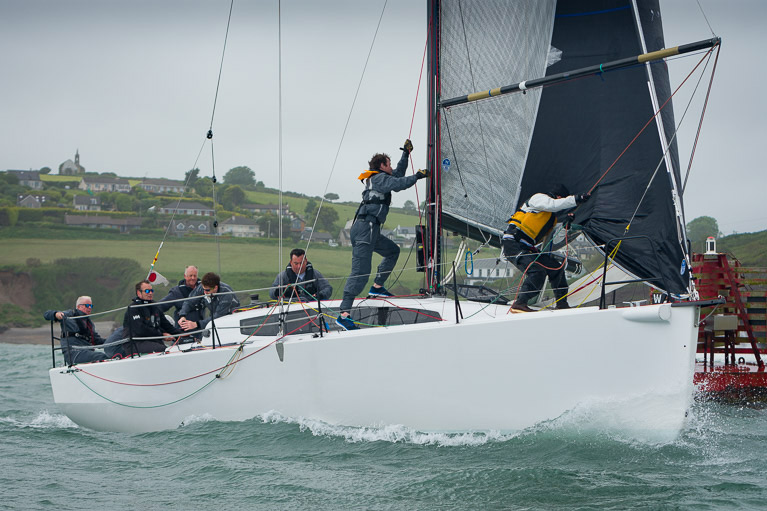 Dublin Bay's own Rockabill VI, the JPK10.80 Dun Laoghaire to Dingle Race winner will race in class one Photo: Bob Bateman
Dublin Bay's own Rockabill VI, the JPK10.80 Dun Laoghaire to Dingle Race winner will race in class one Photo: Bob Bateman
The net result is VDLR 2017 will set sail with a 'super class' by combining 15 mainly race orientated, well sailed and crewed various designs (JPK 10.80, Corby 33's, Archambault 35's, XP33s, Ker and Mills custom yachts) and then adding to it an uber–competitive 14 x J109 fleet.
VDLR had bowed to the agm–wishes of a 14-strong Dublin Bay J109 fleet as far back as January to allow them race in IRC class one as opposed to a separate class as they had done previously in 2015.
It's been no easy job striking the balance and Murphy has consulted far and wide in trying to reach an equitable solution.
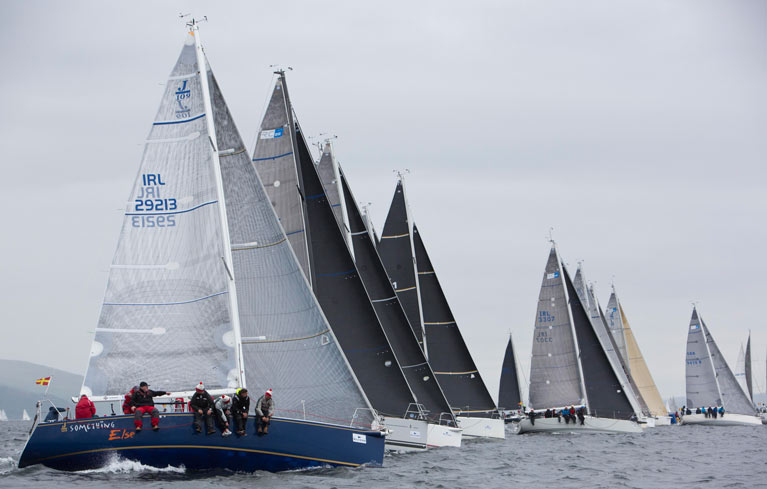 Irish boats racing in the RC35 fleet at the Scottish Series in May. The Scottish class says that having a restricted handicap of 1.015 to 1.040 has encourage tight, competitive racing. Scottish boats will be racing in Dun Laoghaire Photo: Marc Turner
Irish boats racing in the RC35 fleet at the Scottish Series in May. The Scottish class says that having a restricted handicap of 1.015 to 1.040 has encourage tight, competitive racing. Scottish boats will be racing in Dun Laoghaire Photo: Marc Turner
Among the lobbyists, Scottish entries argued against some of their boats being moved into class zero. At May's Scottish Series this 'RC35' group had its own class with four boats from Ireland (including an Irish J109 winner) and the racing was tight and competitive. Having a restricted handicap of 1.015 to 1.040 has encouraged tight, competitive racing and has seen four new owners buy boats to fit into this banding.
If there is a split at VDLR, the new Scottish class argued, it will 'dilute our class and our campaign to encourage its development.'
In correspondence seen by Afloat.ie, other skippers argued, however, that class one's higher rated yachts (of 1.045) will make racing 'grossly unfair' as such boats will get 'clear air off the start line while the balance of the relatively level rated fleet will fight for clear air throughout the race and arrive at marks in unison. Meanwhile, the faster boats 'get richer', one Dublin Bay skipper pointed out.
The problem for Murphy is that the bottom of class one fleet is all J109s so there is 'nobody left to move down to class two'. There is a big gap between 1.045 and class zero so moving such boats into class zero would give them 'poor racing'.
If VDLR did move to split class one, it would leave the J109s racing with just one other class one type yacht.
To say the least, the question has put the organisers between a rock and a hard place.
In one sense, of course, it's a good problem to have because so many other regattas these days have been scratching around looking for entries.
As an additional consideration for organisers, this year's VDLR programme will also feature more racing, up to three races per day, so there is a big onus on VDLR to keep fleets together in order to turn races around quickly.
The net result is VDLR 2017 will now have 29 of the 88 boats in class one, that's 33% of all competing IRC boats.
Start lines
It's an imbalance that admittedly could have unintended consequences for class zero, one and two racing that are racing on the same courses.
For example, how do you set proper lines when class zero will start with five boats and, on the same line, class one will start with 29?
Do they make the line too small for the big class? Or if they make it the right length for the larger class, it will be huge (estimated at 400 metres) for the small class, thus allowing boats that don't start well, the chance to get great starts. It's something Murphy acknowledges and as a means of dealing with the issue he will be using pin end committee boats instead of a buoy to facilitate the setting of the suitably long line for the big class one.
'We plan to set appropriately long start lines and 1.5 mile or longer first beats for the fleet to help reduce bunching at marks'
Equally, Murphy is also investigating the possibility of tying to put in a shorter line for the smaller zero fleet but that will be a tricky thing to achieve within the starting sequence timeframe.
Boat of the Regatta
Another consequence might be its affect on one of the great VDLR traditions and that is its popular 'overall yacht of the week' prize. It's a prestigious award, especially this year when drawn from a total fleet of a near record entry of 473 entries.
How can someone be expected to dominate such a competitive class as class one when it is likely another eight or nine boat classes may produce a dominating boat? It's a factor for organisers to consider because the status of the regatta is diminished if IRC classes are not in the running for this top prize.
Class two and three
Moving down the bands, there are now 17 boats in class two yet only nine in class three. It is, perhaps, a reasonable question to ask why these two classes cannot be combined to make it a 26–boat fleet? If VDLR did this, the spread between the fastest boat and slowest boat would be 57 points. In class one, as they have it now, the spread between fastest and slowest is 50 points.
The answer, says Murphy, after extensive consultation, is that class three is largely made up of vintage –yet modified – Half–Tonners and it is 'unfair to put them with modern class two yachts' because of potential speed differentials.
Racing gets under way tomorrow afternoon.
Cruiser Class One – The Entries
Animal Royal Northern and Clyde YC GBR3627L First 36.7 1.021 Kevin Aitken
Banshee Clyde Cruising Club GBR9470R Corby 33 1.040 Charlie Frize
Bon Exemple Royal Irish Yacht Club GBR8933R X-Yachts 1.017 Colin Byrne
Carmen II Helensburgh Sailing Club IRL1666 First 36.7 1.019 Alan Jeffrey
Ruth National Yacht Club IRL1383 J109 1.015 Shanahan Family
Something Else National Yacht Club IRL29213 J109 1.011 John Hall
Chimaera Royal Irish Yacht Club IRL2160 J109 1.015 Andrew Craig
Jalapeno National Yacht Club IRL5109 J109 1.014 Paul Barrington
Jigamaree Royal Irish Yacht Club IR7991 J109 1.011 Ronan Harris
Joker 2 Royal Irish Yacht Club IRL1206 J109 1.013 John Maybury
Juggerknot Royal Irish Yacht Club IRL3660 J109 1.017 Andrew Algeo
Jump The Gun Royal Irish Yacht Club IRL1129 J109 1.012 John Kelly
Indecision Royal Irish Yacht Club IRL9898 J109 TBA Declan Hayes
Powder Monkey 2 National Yacht Club IRL28898 J109 1.009 Christopher Moore
D-Tox Royal Irish Yacht Club IRL13500 X 35 1.043 Patrick McSwiney
Gringo National Yacht Club Irl 7778 A 35 1.023 Anthony Fox
Impostor South Caernarvonshire YC GBR7377 Corby 33 1.035 Richard Fildes
Jacob VII Port Edgar IRL3307 Corby 33 1.039 John Stamp
Now or Never 3 Fairlie Yacht Club GBR7667R MAT 1010 1.032 Neill Sandford
Prima Luce Royal Irish Yacht Club IRL3504 First 35 1.017 Patrick Burke
Raptor Royal Irish Yacht Club IRL811 Mills 30CR 1.013 Denis Hewitt
Rockabill VI Royal Irish Yacht Club IRL10800 JPK 10.80 1.048 Paul O’Higgins
Thalia National Yacht Club IRL733 Sigma 400 1.035 Aubrey Leggett
Triple Elf Clyde Cruising Club FRA37296 Beneteau First 35 1.020 Christine Murray
Valkerie Liverpool Yacht Club GBR7031T Ker 31 1.027 Austin Harbison
White Mischief Royal Irish YC/National YC GBR1242R J109 1.010 Richard Goodbody
Wavetrain Greystones Sailing Club IRL 1477 Channel 32 1.014 Frank Whelan
Second UK IRC Nationals Title for Whooper
With a near perfect scoreline, Giovanni Belgrano's 1939 classic yacht Whooper was crowned 2017 champion at the Royal Ocean Racing Club's IRC Nationals. Today, two windward-leeward races were held on the Solent in similar brisk southwesterlies to the first two days. This year's event may not have been an 'all-round test' weather-wise, but has been extremely challenging in terms of preparation and boat handling.
During the event Whooper, a classic Laurent Giles sloop that was previously IRC National Champion in 2004, scored six bullets, a fourth and a discardable DNF in the final race.
Whooper is no rating demon. She is optimised with modern sails and Belgrano has an experienced crew who do 60-70 races/year.
Elsewhere, the racing was extremely close. In the FAST 40+, Johnny Vincent's Pace fended off charges from Peter Morton's brand new Carkeek 40 Mk3, Girls on Film to win by a slender two points. Today Pace scored a 1-3 to Girls on Film's 2-1.
IRC One concluded with a dog fight for the lead between the Ker 46 Lady Mariposa and Ker 40 Keronimo. The larger boat held a two point lead going into the final race in which they suffered a major blow, being over the start line early.
Finally they managed to shake Keronimo off and were able to get up to speed until they had to make a last minute change to their lighter spinnaker, despite the wind building to above 20 knots. "We were praying that it would hold to the finish," recalled Hardy. Ultimately finishing fourth to Keronimo's second left them tied on points, claiming IRC One on countback.
In IRC Two there was a leader change with Ed Fishwick's Sun Fast 3600 Redshift Reloaded, leader all weekend, finally trounced by Adam Gosling's JPK 1080+ Yes! who came very close to successfully defending their IRC Nationals title.
As to relinquishing the IRC National title to Whooper, Gosling said: "Giovanni sails really well. He's campaigned Whooper for a long time. It is nice to see an old boat win."
Results are here
Strong Wind Start To RORC IRC Nationals
With the southwesterly piping up to 30 knots in the final race, the RORC IRC Nationals got off to a brisk start on the Solent today with two windward-leewards followed by a round the cans race.
Appropriately, given this is an annual championship for Royal Ocean Racing Club's rating rule, it is a mix of both the newest boats and the very oldest, that lead at the conclusion of day one.
Star performer was Ed Fishwick's Redshift Reloaded which scored straight bullets in IRC Two and now lead reigning IRC National Champion, Adam Gosling on the JPK 1080+ Yes! by five points.
Fishwick typically races his new Sun Fast 3600 doublehanded offshore, but has a full crew for this event. "Today it was mainly about getting good starts and staying upright," he explained. "We are one of the lower rated boats in IRC Two, so it was critical to get good starts and we got them, which meant we were in touch all the way up the first beat. It was very shifty and we had to do an unusual amount of tacking on shifts, but we got it right."
While their competitors were broaching around them, Redshift Reloaded's broad beam and twin rudders helped the crew keep her on her feet as the wind reached 28 knots, although even they suffered one wipe out.
The attrition rate was highest in the FAST40+ class where only four of the nine entries completed the third race. At the end of the race two, Johnny Vincent's Ker 40+ Pace was tied on points with Girls on Film, the brand new Carkeek 40 Mk3 of 2016 FAST 40+ champion, Peter Morton. However, this was not to continue for Morton, who recounted: "The problem was that our bilge pumps weren't working and we were slowly filling up with water which we couldn't get rid of. In the third race we were going down. We had about 2.5 tonnes of water on board and couldn't finish the race."
Nonetheless Morton was pleased with their performance up until then on his brand new boat. "The first time we pulled a spinnaker up was at the weather mark, but the boat feels really good. We are fast upwind and downwind. It's just not designed to carry two tonnes of water..."
The previous Girls on Film, now Bastiaan Voogd's Hitchhiker holds second, tied on points with Mark Rijkse's 42°South, with Pace leading by six points.
In IRC One, Andy Williams's Keronimo is also leading on six points after scoring a consistent 2-2-1 today - a fine performance, this being the Plymouth-based Ker 40's first major outing of the year.
"We had an up and down day - it was quite busy and bumpy and windy, but we really enjoyed it," recounted Williams. However it nearly all unravelled in the breezy final race. "We managed to drop the A4 in the water on the hoist and shredded it with the whole race ahead. But we worked very hard and what got us the race was the last leg - it was a tight reach and we flew an A0 fractional. We were underwater doing 17-18 knots all the way down and we literally made all our time with everyone hanging out the side, properly submerged."
In the first two races Keronimo was playing second fiddle to her bigger, newer brother, the Ker 46 Lady Mariposa. She is fastest boat in IRC One, but had to retire from race three with broken battens.
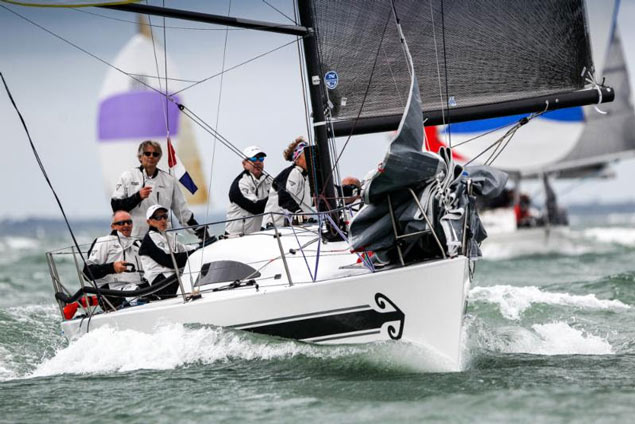 Racing in IRC Three, Philip Plumtree's Halftonner, Swuzzlebubble Photo: Paul Wyeth
Racing in IRC Three, Philip Plumtree's Halftonner, Swuzzlebubble Photo: Paul Wyeth
In IRC Three, Mike Bridges' Elan 37 Elaine won race one, but in the second and third it was the turn of renowned structural engineer Giovanni Belgrano and his Laurent Giles classic shoal-draught centreboard sloop, Whooper, winning both races to take the lead overall. A 1939 vintage, Whooper is the oldest boat competing and won the IRC Nationals back in 2004 when Belgrano says conditions were similar to today.
"It was a battle for everyone," said Belgrano of racing today. "But we do well against the modern boats in these conditions." Whooper was progressively reefed during the day, having started off on too generous a jib.
"She has a good hull shape, she was ahead of her time," added Belgrano of his steed. With a displacement of 7.2 tonnes, Whooper has great stability, but even she came a cropper in the lumpy wind-against-tide seas. "We were doing 11-12 knots. We did what may have been our first nosedive and we had green water on the foredeck. We came out of a gybe and we were probably 70° on our side," concluded Belgrano.
Tonight many teams are licking their wounds with much boat work to complete before another full day of racing tomorrow.
Royal Ocean Racing Club's IRC Nationals Has 53–Boat Fleet
Racing gets under way this Friday on the Solent for the cream of the British keelboat fleet at the Royal Ocean Racing Club's IRC Nationals writes James Boyd.
The rating rule will create a level playing field between the 53 boats entered ranging from the fastest, the Ker 46 Lady Mariposa, to the slowest, the two Quarter Tonners. In between it must cope with planing machines such as the eight FAST40s or Jamie Rankin's Farr 280, Pandemonium, to the Quarter and Half Tonners originally designed to the IOR rule to Giovanni Belgrano's 1939 Laurent Giles classic, Whooper.
Three 46 footers are competing. In addition to Lady Mariposa is Colin Campbell's Azuree 46 Eclectic, theoretically slowest of the trio. In between is the Marc Lombard-designed Pata Negra, chartered for the summer by the Dutch de Graaf family, who previously campaigned the Ker 40, Baraka GP.
In IRC One they will also face their old foe, Andy Williams' Ker 40 Keronimo, and Tor McLaren's MAT 1180, Gallivanter. There will also be a trio of J/111s, Simon Bamford's Kestrel, Paul Griffiths' Jagerbomb and Cornel Riklin's Jitterbug.
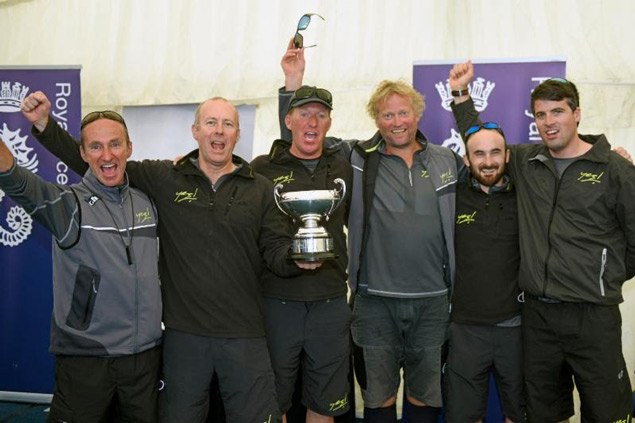 Adam Gosling's JPK 1080 Yes! is back to defend their title as joint winners last year with Irish crew James Hynes (third from left) and Nicholas O'Leary (right) Photo: Rick Tomlinson
Adam Gosling's JPK 1080 Yes! is back to defend their title as joint winners last year with Irish crew James Hynes (third from left) and Nicholas O'Leary (right) Photo: Rick Tomlinson
A favourite for this year's title is former RORC Commodore Mike Greville and his trusty Ker 39, Erivale, having come so close to winning last year.
Among the eight FAST 40+s all eyes will be on the latest generation Carkeek design, Girls on Film of 2016 class winner Peter Morton. With a modified cockpit layout compared to her predecessor (now Bastiaan Voogd's Hitchhiker), the IRC Nationals will be her first competitive outing having freshly arrived from her builder in Dubai.
IRC Two will see a dust up between five First 40s, including La Reponse of RORC Admiral Andrew McIrvine, who memorably scored three straight bullets on the final day of the IRC Nationals. On that occasion he was beaten to the class win by Adam Gosling's JPK 1080+ Yes!, ultimately crowned joint IRC National Champion. Yes! will return to defend her title.
IRC Three includes regular campaigners such as Harry Heijst's S&S 41 classic, Winsome, Mike Moxley's HOD35 Malice and Mike Bridges' Elan 37 Elaine.
Alongside Quarter Tonners, Berry Aarts' Wings and Tom Hill's Belinda, Phil Plumtree's Half Tonner, Swuzzlebubble, and Whooper, one of the lowest rated is the Poole-based MG 346, MS Amlin Enigma of Ian Braham.
Racing at the RORC IRC Nationals takes place over 23-25th June with a first warning signal each day at 1050
The Lymington (UK) based Rating Office, headquarters of the world's most popular rating system IRC, is to be managed by Dr Jason Smithwick. Following on from academia, roles in the research industry and sailing's international federation Smithwick will take up his post at the head of a team of four full-time staff and several external consultants on 3rd July this year.
Established in 1974 the Rating Office has been coordinating the measurement of sailing boats and the issuing of rating certificates for over 43 years. Regarded by many as 'the centre of excellence for yacht measurement' it is one of very few mythical buildings in the world of sailing. The work that has been done inside its four walls over the years, producing ratings and handicaps for sailing boats of all shapes and sizes so as to race equitably over long and short courses, is the foundation piece of a huge multi-billion pound international sport and its associated industry. Over the years the Rating Office staff have been coordinating the measurement and rating of everything from IOR boats in the '70s and 80's, IMS in the early '90s and CHS in the '80s and '90s which evolved into IRC in use today.
In addition to calculating ratings the office is involved in the management, measurement and in some cases, the creation of class rules for fleets such as the Whitbread 60, the current VOR 65, the new Club Swan 50, Swan 45 class, Mumm 30 and Mumm 36 classes, Nautor Swans, Wallys, Maxi 72 and countless other sub-groupings that use the IRC Rule today. The Rating Office is also actively involved in international safety standards for yacht racing and has key roles in RYA and World Sailing working groups and committees.
Dr Jason Smithwick (45) graduated from Southampton University in 1994 continuing in the world of academia for another 10 years gaining his doctorate and eventually ending up as Principal Engineer & Software Manager at the world renowned Wolfson Unit. The next stage in his career was in the role of Technical and Offshore Director at sailing's international federation, known today as World Sailing.
"The role of Director of Rating is something that completely fits my experience and passion. Racing yachts, numbers and the greater racing community is what gets me out of bed in the morning. This is a dream job and I am honoured to follow in a long line of individuals that have handled this foundation piece of the sport of yacht racing and continue the important work that has been done by my predecessors and their colleagues," said Dr. Smithwick.
With rating rule stability in a dynamic technological age owners, clubs, sponsors and the marine industry at large can continue to invest with real confidence in the sport of sailing.
"I'm really pleased to find someone of Jason's experience and technical knowledge to head up the Rating Office in Lymington. The importance of the role played by the Rating Office staff over the years cannot be overstated. By calculating ratings and issuing rating certificates the foundation for equitable racing between disparate boats is established. This in turn enables many thousands of sailing boats to populate regatta and club race courses the world over. Jason's appointment will give IRC especially, and the sport in general, stability and real confidence for the future," said Eddie Warden Owen, RORC Chief Executive and Interim Rating Office Director
No Crew Limit for ICRA Nationals, IRC Rule 22.4 Stays Deleted for Royal Cork Championships
There will be no crew number limitations or crew weight limitations at this year's Irish Cruiser Racer (ICRA) Nationals at Royal Cork Yacht Club.
The rule had been 'under review' following discussion at March's ICRA Conference in Limerick where it was shown different regattas deal with crew weight limits in different ways.
Yesterday, ICRA Commodore Simon McGibney confirmed to Afloat.ie, 'There is no change to point five of the Notice of Race for this year's Championships'.
Point five says: Crew Limitations IRC Rule 22.4 is deleted. There is no crew number limitations. There is no crew weight limitations.
IRC Rule 22.4 says: “The Crew Number printed on each boat’s certificate shall not be exceeded or the crew weight shall not exceed 85kg multiplied by the Crew Number printed on the certificate.”
The decision brings clarity to a situation six weeks after a healthy debate on the issue at the national conference and six weeks before the championships is set to sail in Cork Harbour.
It means competing skippers are now free to invite as many crew as they wish and book accommodation at Crosshaven accordingly.
The focus of conversation at the conference, under guest speaker Mike Urwin of the RORC, was the disposal of crew limits at events such as the ICRA National Championships.
As the rule does not apply at the ICRAs, boats had an option to take less crew on a light wind day and stack the rail in breeze.
Traditionally, fun regattas like Calves Week, did not have crew limits, so that late crew members could be recruited from the quayside and children could also be accommodated as required.
The move to delete the limit rule followed significant consultation with sailors and ICRA surveys found overwhelming support for its withdrawal.
However, the meeting heard that for 'serious regattas', such as a national championships, not having a crew limit can lead to advantages to those who bring a large crew pool to an event, thus upping overall costs of participation.
Some delegates believed championships should stick to the IRC certificate crew limit or maybe the 'cert plus one'. Others thought a stipulation in the Sailing Instructions requiring the same crew numbers in every race would be helpful.
An Afloat.ie reader poll following the conference (running from March 9 to April 25) recorded answers from eight countries, with 45% of respondents from Ireland.
The poll asked: 'Should there be a crew limit at ICRA 2017?' Answer options: No – Let them all race! or Yes – Reinstate IRC Rule 22.4. There was a strong result (73%) for the reinstatement of IRC Rule 22.4.
Results are below:

RORC Announce Two New GBR IRC Championships
The International Rating Certificate (IRC) global rating rule is used for hundreds of events in 40 countries. In UK waters IRC competition is fierce both for the National Championship, organised by the Royal Ocean Racing Club, and for regional championships which range from Scotland to the Channel Islands.
Two new IRC Championships have been added for 2017: an Inland Championship on Lake Windermere and an Autumn Championship organised by Hamble River SC – both add an extra challenge to an existing winter series. In addition to regional events there are championships for Small Boats and Double Handed crews.
Winners of each Championship will also win a special prize package from IRC sponsors Spinlock.
The 2017 GBR IRC Championships are:
Solent (May-October)
Scottish (May)
Sussex (June)
Channel Islands (June)
National (June)
East Coast (July)
Welsh National (August)
South West (August)
Southern (September)
Small Boat (September)
Double Handed (September)
Autumn (September)
Inland (November-March)





























